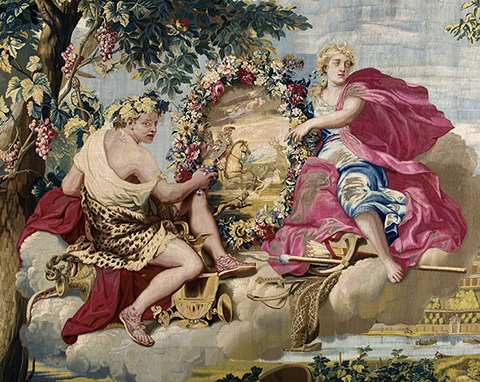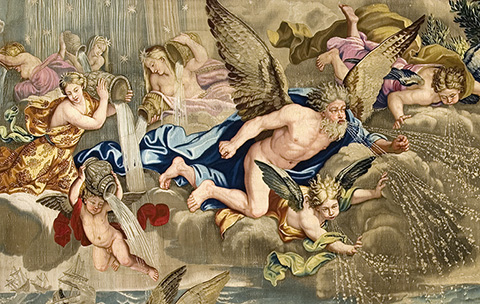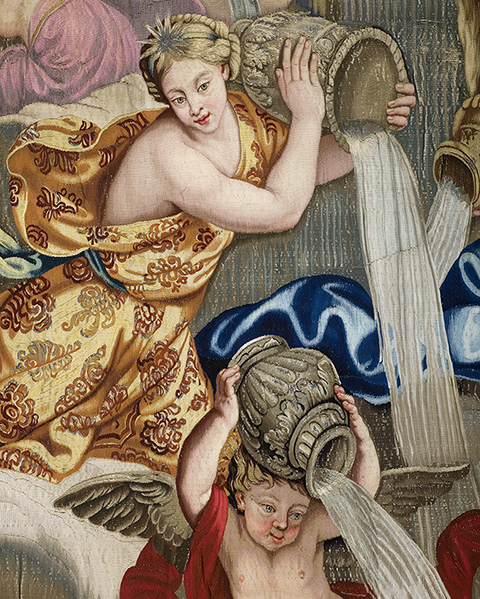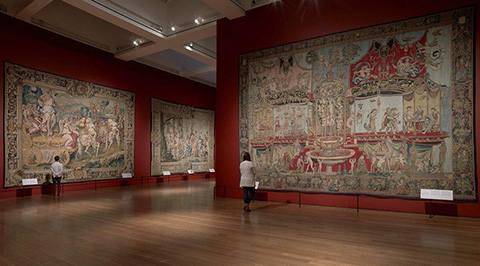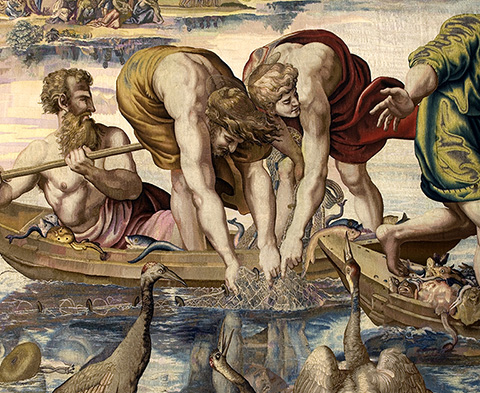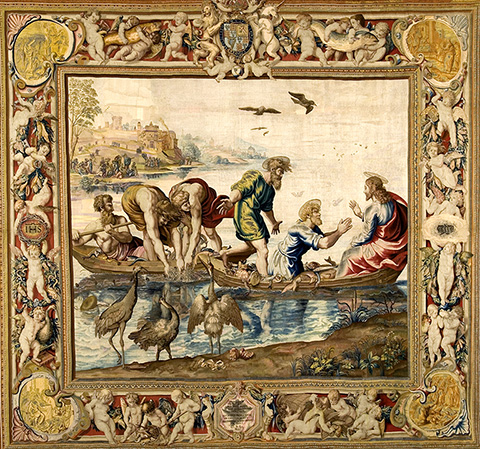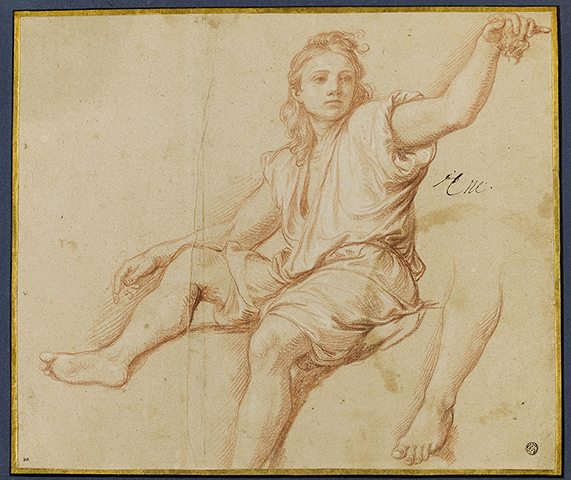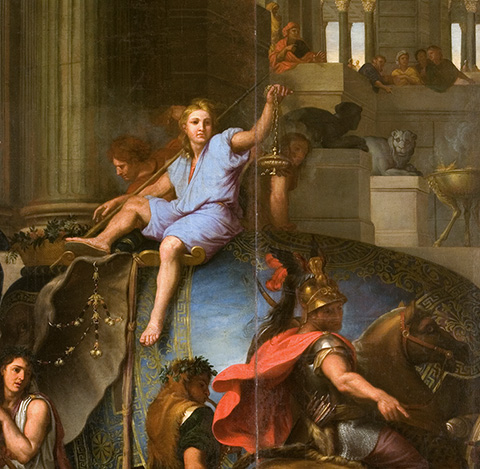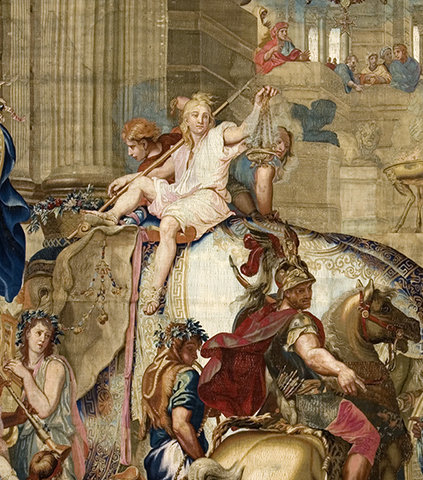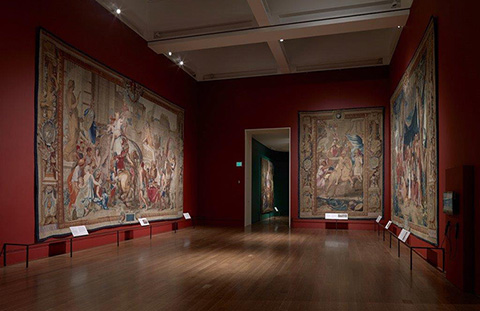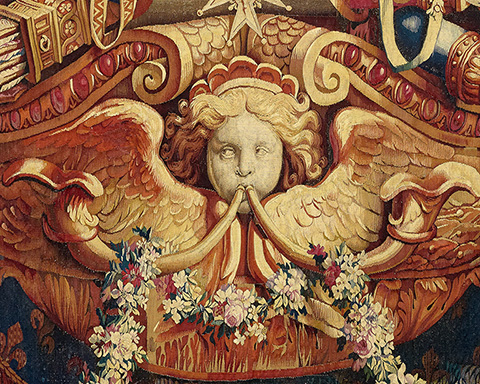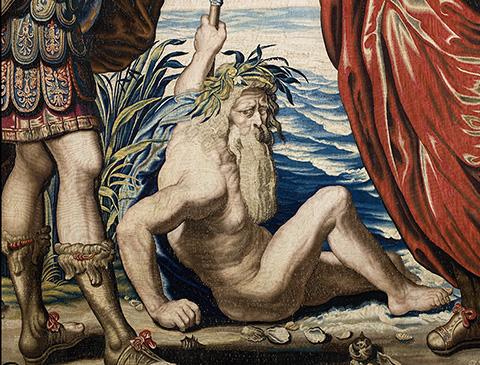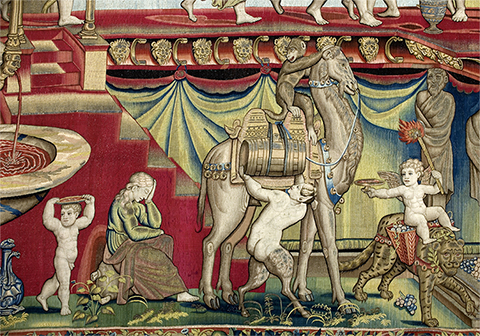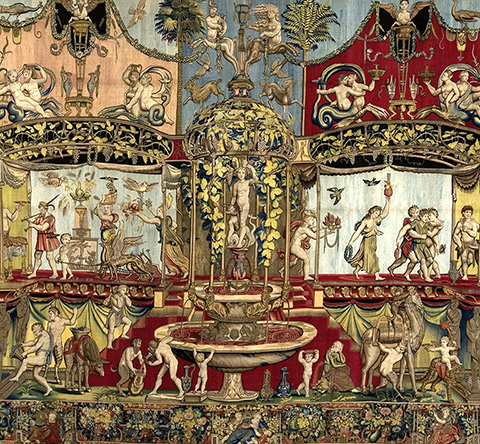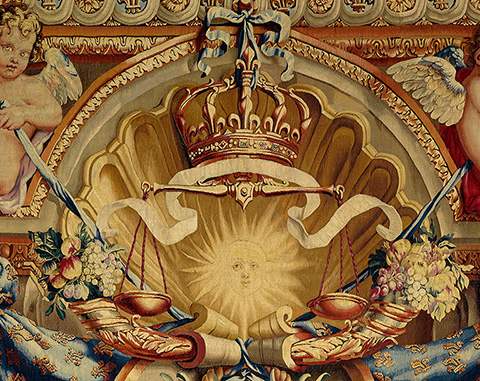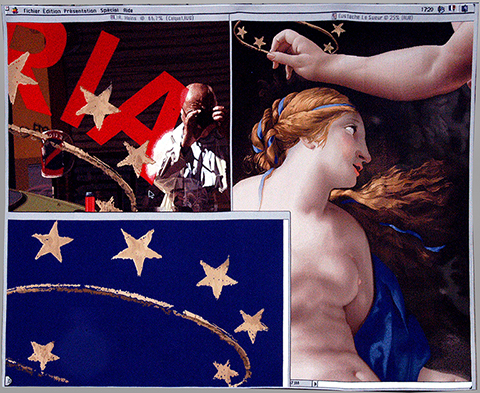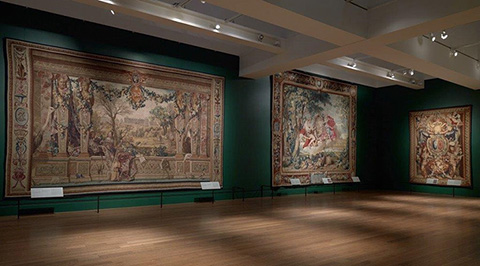Florian Knothe, director of the University Museum and Art Gallery at the University of Hong Kong, examines the meticulous planning and training of workers involved with the production of tapestries at the royal manufactory in Gobelins, Paris, during the second half of the 17th century. The workshops at Gobelins produced luxurious works of art that served the political and social needs of Louis XIV, and became some of the most stylistically influential artworks of their period.
Saturday, January 23, 4:00 p.m.
Getty Center: Museum Lecture Hall
Woven Gold: Tapestries of Louis XIV
December 15, 2015–May 1, 2016Getty Center
The Sun King, Louis XIV of France, who reigned from 1643 to 1715, formed the greatest collection of tapestries in early modern Europe. Extraordinary resources of time, money, and talent were allocated to the creation of these works, which were meticulously woven by hand with wool, silk, and precious metal-wrapped thread, after designs by the most esteemed artists.
As patron, heir, and collector, Louis XIV vastly augmented the prestigious French royal collection of tapestries. Displayed within his palaces while in residence and in outdoor courtyards on feast days, these monumental hangings embodied and proclaimed his magnificence.
The legacy of tapestry weaving as a national endeavor continues in France today, with state commissions from contemporary artists such as Raymond Hains who designed Diptyque/I. With rare loans from the Mobilier National, this major international loan exhibition presents a selection of grand tapestries that evoke the brilliance of the Sun King’s court.
This exhibition was organized by the J. Paul Getty Museum in association with the Mobilier National et les Manufactures Nationales des Gobelins, de Beauvais et de la Savonnerie.
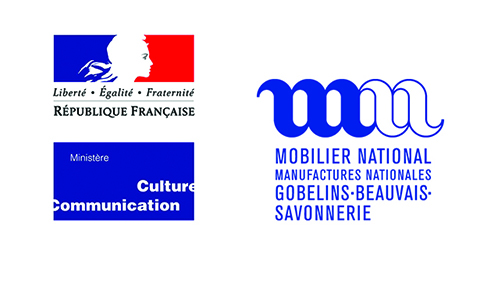
We gratefully acknowledge the Hearst Foundations, Eric and Nancy Garen, and the Ernest Lieblich Foundation for their generous support.
RELATED EVENTS
A variety of special programs complement the exhibition. All events are free, unless otherwise noted. Seating reservations are required. For reservations and information, please call (310) 440-7300 or see information on planning a visit.
TALKS
Making Tapestries Now: Digital Jacquard and a Renewed Form
Artist John Nava, who designed the Jacquard-tapestry cycles for the Cathedral of Our Lady of the Angels, speaks about the creation of monumental tapestries today.
Sunday, April 3, 4:00 p.m.
Getty Center: Harold M. Williams Auditorium
SYMPOSIUM
Apollo & Arachne: Louis XIV and the French Royal Collection of Tapestries
Art historians and tapestry scholars present new insights about the royal collection of tapestries assembled during the 72-year reign (1643-1715) of Louis XIV. Topics range from the strategic acquisition of revered antique sets, to the iconographic power of new commissions, to the reception and dissemination of Gobelins weavings among private patrons. This one-day symposium coincides with the exhibition on view at the Getty Center.
Admission is free but advance registration is required by January 14.
Sunday, January 24, 10:00 a.m.–4:30 p.m.
Getty Center: Museum Lecture Hall
Learn More
COURSES
Artist at Work: Tapestry Weaving
Colorful and glittering tapestries, handwoven after designs by the most renowned artists, were the ultimate expression of power, taste, and wealth during the reign of Louis XIV. Join tapestry conservator and weaver Yadin Larochette in an exploration of the materials and techniques used to produce the monumental tapestries featured in the exhibition. This is a free, drop-in program.
In Gallery
Experience a live weaving demonstration by Yadin Larochette in the exhibition galleries while viewing the extraordinary tapestries of Louis XIV.
Tuesdays: January 5, 12, 19, February 2, 9, 16, March 1, 15, 29, 1:00–3:00 p.m.
Getty Center: Special Exhibitions Pavilion
In Studio
Join Yadin Larochette for an interactive introduction to the materials and techniques used to create beautiful, handwoven tapestries from the initial design to the final stages of manufacture.
Sundays: January 17, February 7, 28, and March 20, 1:00–3:00 p.m.
Getty Center: Museum Studios
Culinary Workshop: A Taste for Luxury
Louis XIV, France’s Sun King, was a preeminent tastemaker with an appetite for fine art and haute cuisine. Join chef and educator Robin Trento in a hands-on exploration of the elaborate culinary practices of the 17th-century French court. Visit two spectacular exhibitions—Woven Gold: Tapestries of Louis XIV and The Edible Monument: The Art of Food for Festivals—and prepare a class meal fit for a king. Course fee $95. Complimentary parking. Tickets available beginning Tuesday, January 15.
Thursday, February 25, 10:30 a.m.–2:30 p.m. Repeats Friday, February 26
Getty Center: Private Dining Room
Froth and Folly: Scent for 18th-Century French Nobility
Which scents wafted through the air at the Palace of Versailles? Join Saskia Wilson-Brown of the Los Angeles-based Institute for Art and Olfaction for a historical introduction to perfumery. Explore the materials used to create potpourri, fragrance waters, and perfume oils in France during the 18th century and create your own historic fragrance in this hands-on workshop. Course fee $65 (includes materials). Complimentary parking.
Saturday, February 27, 1:00–5:00 p.m.
Getty Center: Museum galleries and Museum Studios
![]()
TOURS
Curator’s Gallery Tour
Charissa Bremer-David, curator of sculpture and decorative arts, the J. Paul Getty Museum, leads a gallery tour of the exhibition. Meet under the stairs in the Entrance Hall.
Wednesdays: December 16, January 6 and 20, February 3 and 24, March 9 and 23, April 6 and 20, 1:30 p.m.
Getty Center: Special Exhibitions Pavilion
VIDEO
The Art of Making a Tapestry
This 9-minute video explores the process of tapestry weaving at the Gobelins Manufactory in Paris, where historical techniques, dating back to the time of Louis XIV, are used to make contemporary works of art.
Exhibition Text & Checklist
MOBILE TOUR
Free GettyGuide® Multimedia Player

Go to getty.edu/tapestries on your smartphone; bring your own headphones or pick up a multimedia player free of charge in the Museum Entrance Hall. Join GettyLink for free Wi-Fi during your visit.
IRIS GETTY BLOG
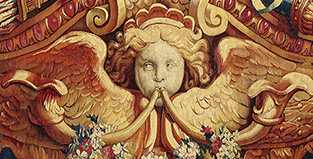
Cleaning 700 Square Feet of Precious Tapestry
Getty Iris article by Kim Sadler I December 15, 2015
PUBLICATIONS
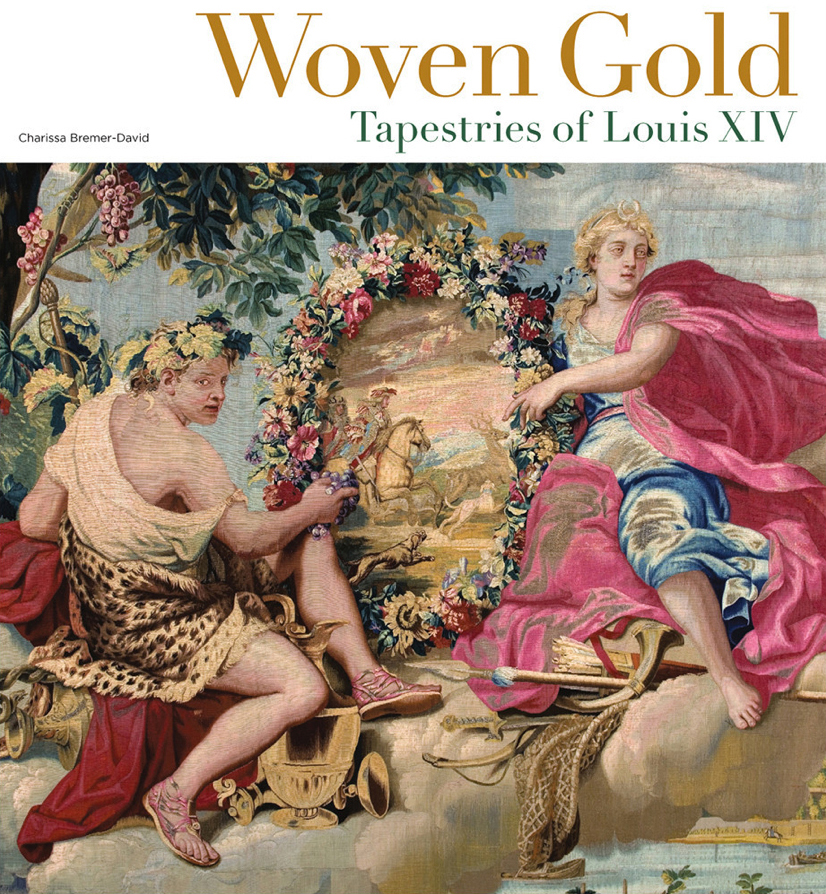
Woven Gold: Tapestries of Louis XIV
Charissa Bremer-David
With essays by Pascal-François Bertrand, Arnauld Brejon de Lavergnée, and Jean Vittet
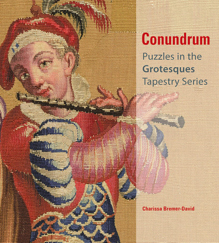
Conundrum: Puzzles in the Grotesques Tapestry Series
Charissa Bremer-David
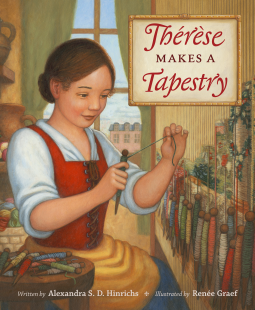
Thérèse Makes a Tapestry
Alexandra S. D. Hinrichs
Illustrated by Renée Graef
